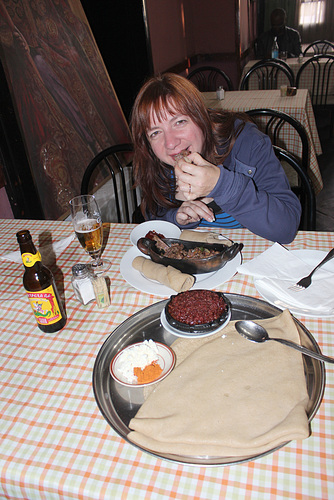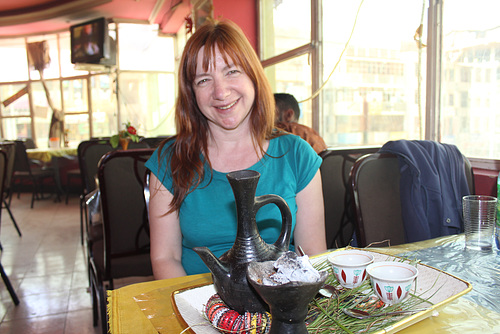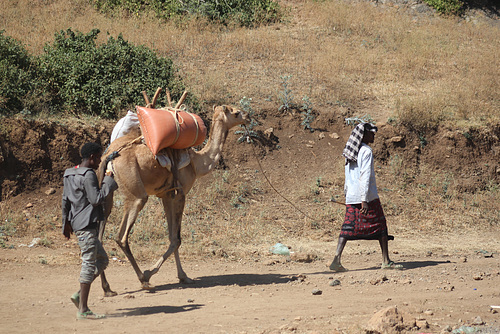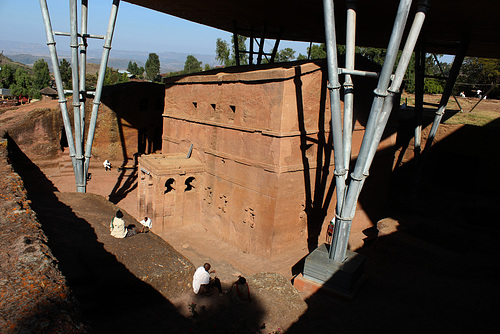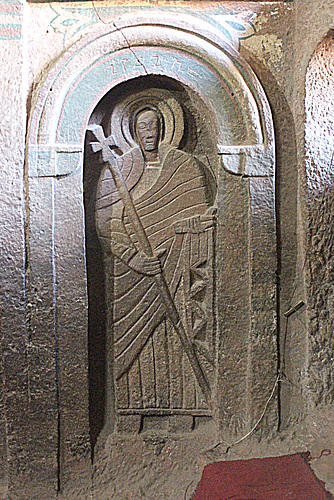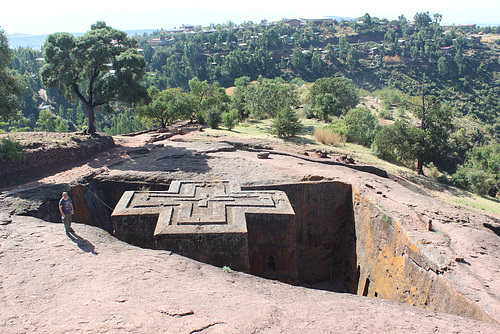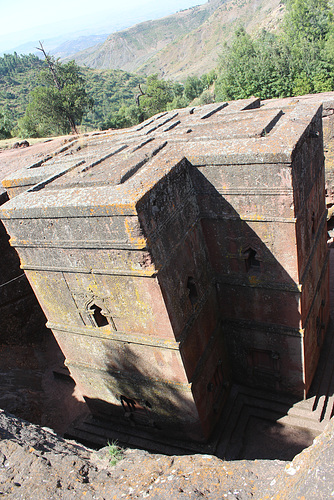18 to 23 December, 2014 - Mekele, Danakil Depression (Harmadela, Erta Ale, Lake Asale, Dallol) - (Ethiopia)
Our next stop north was Mekele. We managed to score a ride meaning we covered the distance in a single day instead of the anticipated two. The extra day was spent enjoying town and shopping.
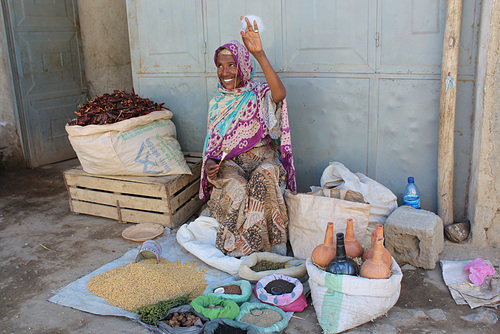
In the Market at Mekele
A beautiful smile, spinning by hand, selling her spices and coffee pots.
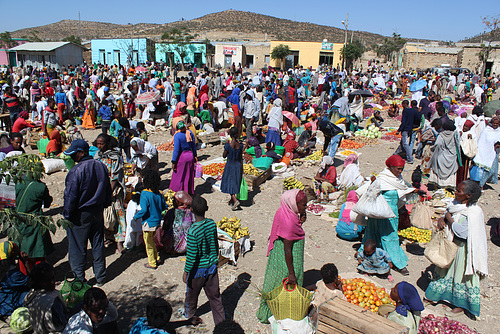
Berhale Market
Our reason for coming to Mekele was to arrange our time in the Danakil Depression. The Danakil Depression is a vast low area in northern Ethiopia, largely below sea level. It is hot. In summer it regularly goes over 50 celcius (although it only makes high 30's at this time of year). It is desolate. And it has some beautiful sights to see. Not least of all is the opportunity to see the way people live in such a place. Being close to the Eritrean border, soldiers and guards are never far. There are some who make a bit of money from tourism, either directly or otherwise. However, it seems the vast majority live here because of the salt extraction. They cut salt, or they transport salt, or they trade with the camel caravans. Such a brutal environment to live and work in. Sometimes, we drove kilometres without seeing a single thing growing, yet people live there, with a handful of goats. Oasis dot the land, and we were told there was no shortage of water just below the surface, suitable for animals at least. Or human consumption if desperate enough, but the people know how to make it OK for drinking.

Afar Man with Camel

Jo Gets her Hair Done
While sitting in a small village, waiting, the children gathered, and soon Jo was getting plaits done from all angles.

Camel Train Near Harmadela
Camels laden with salt. Destination, Mekele. Seven days travel from the salt flats.
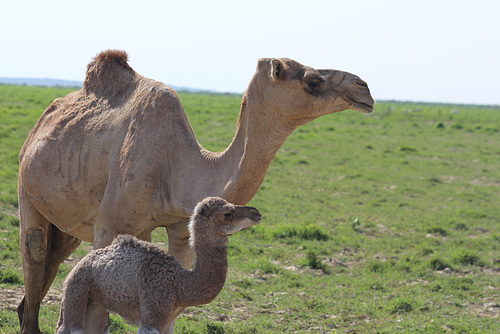
Mum and Bub
Mother and baby camel in the Danakil depression.
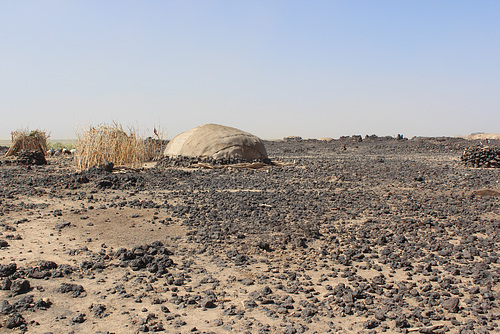
Living where Almost Nothing Grows
Not many people live around here. The environment is incredilbly harsh and unforgiving. How anyone manages at all is beyond me.
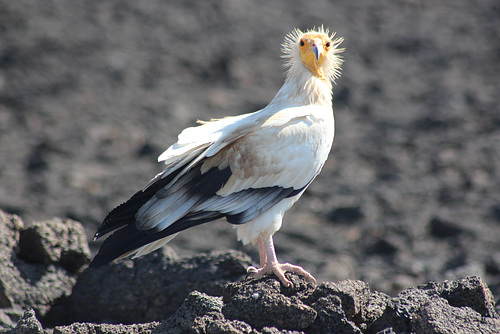
Egyptian Vulture
Despite the feeling that nothing could survive here, it obviously does. Occasional birds this size must feed on small prey, which in turn feed on bugs and insects, which all have something to survive on. The complete cycle is here, difficult as it is to find.
While that was all interesting and worthwhile, nothing was even a close second to the main reason for our trip here. To climb Erta Ale and spend a night on the rim, next to the world's only permanent lava lake.
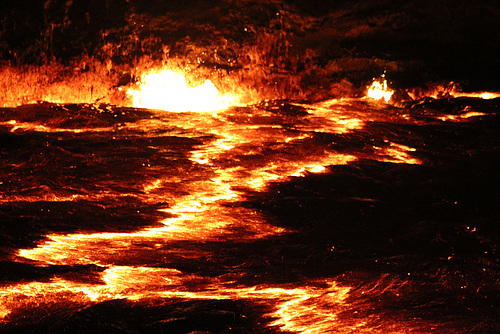
View in to Erta Ale
The thin fresh crust of rock tries to form over the massive lake of lava, but it is quickly liquified and absorbed once more in a cycle of heating and cooling.
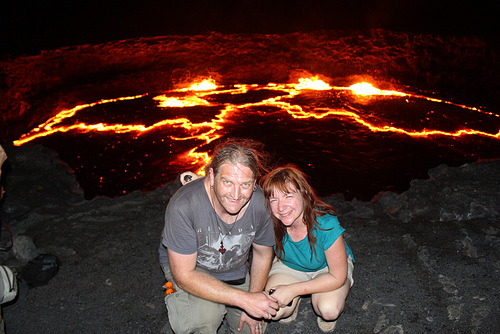
Late at Night, Erta Ale Volcano
We ascended after dark to avoid the desert heat, and spent most of the evening and morning admiring one of the most amazing sights. I even singed the hair on my arms standing there. We camped on the rim of the crater (not precariously near the edge, though!) and admired the lava lake for sunrise, heading down before it got too hot.

Rolling and Rippling Molten Lava
Mesmerising changing formations in the Erta Ale lava lake, as rock changes state between molten and solid and back again.

Surreal Vistas Created by the Shifting Crust
Erta Ale lava lake. The cracks caused by the molten lava expand into immense bubbling pools before cooling just enough to crust over.

Bubbling Lava Shooting Dozens of Metres
Beautiful shapes and patterns appeared when large pools of lava became so intense that they bubbled and frothed erratically and spurted skywards.

Like Lightning
Lava in the Erta Ale Volcano crater.

Lava Bursting Through
Pressure beneath the crust causes a dramatic break out of lava. Erta Ale Volcano.
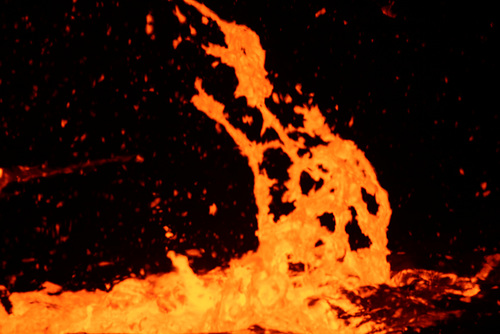
More Lava Leaping
Erta Ale Volcano.
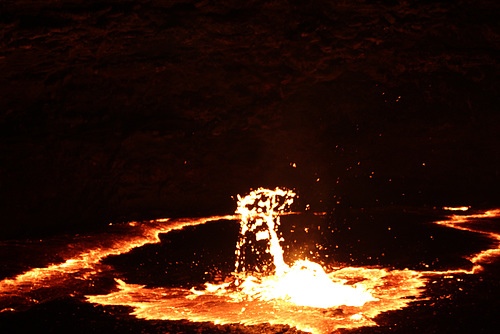
A Gigantic Spurt of Lava
Besides the need to avoid desert heat, the lava activity is so much easier to take in when it is dark. Erta Ale creates an incredible, though momentary, lava "tree" for us.

Wide Angle - Erta Ale Crater
Thankyou, Carl, for lending me your lens. Last photo before going to bed.
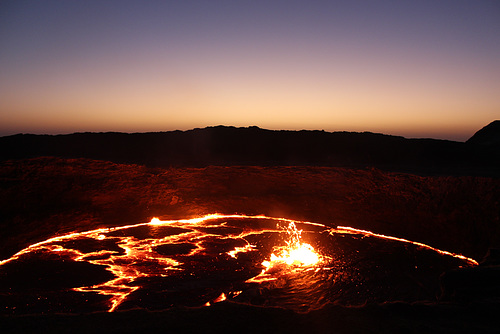
Sunrise by a Lava Lake
No reflections in this lake, though. Dawn comes, and there was a new appreciation of Erta Ale. The lava activity and the sun rising were a perfect pair.

Daylight Begins to Enter the Crater
As the sun rose, we could finally see the warped countours of the lava lake crust. But day or night, Erta Ale never sleeps.
With so much land below sea level, so much water coming in, and so much sun, salt is the natural by-product. We stoon on Lake Asale's shore at sunset, seeing white in 3 directions almost to the horizon, and blue in the 4th.
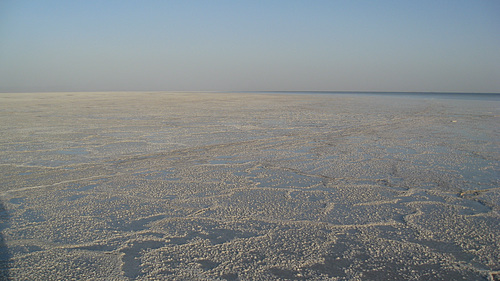
Lake Asale, Ethiopia
Standing on the shore of the salt laden Lake Asale, in the Danakil Depression.
Another amazing area is the volcanic active area around Dallol. After climbing over centuries old lava flows, we came to the sulphur springs. Smelly? Actually, not as bad as you might imagine!
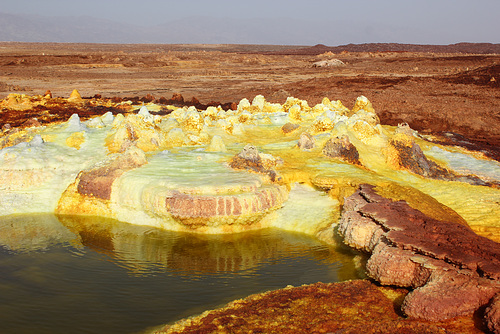
Sulphur Formations
Sulpur laden water bubbles to the surface and evaporates. Dallol in the Danakil Depression.

Striking Yellow - Sulphur - Dallol
Another cluster of sulphur formations in the Danakil Depression.

Ethiopian Soldier
And before leaving the depression, we stopped in a much drier area to see the salt extraction in progress.

Salt Extraction Site
A camel waits while in the background, salt blocks are cut and cleaned, ready for loading. Ragad, in the Danakil Depression.
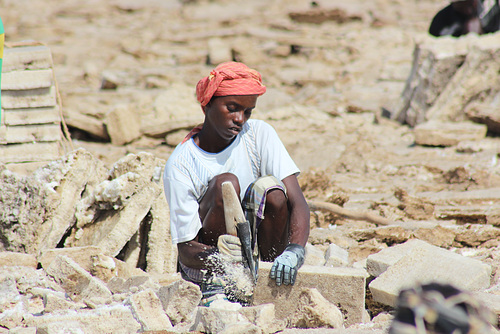
Cutting Salt Blocks
A worker cuts blocks of salt into manageable sizes, ready for transport by camel to Mekele. Ragad, Danakil Depression.
Our next stop north was Mekele. We managed to score a ride meaning we covered the distance in a single day instead of the anticipated two. The extra day was spent enjoying town and shopping.

In the Market at Mekele
A beautiful smile, spinning by hand, selling her spices and coffee pots.

Berhale Market
Our reason for coming to Mekele was to arrange our time in the Danakil Depression. The Danakil Depression is a vast low area in northern Ethiopia, largely below sea level. It is hot. In summer it regularly goes over 50 celcius (although it only makes high 30's at this time of year). It is desolate. And it has some beautiful sights to see. Not least of all is the opportunity to see the way people live in such a place. Being close to the Eritrean border, soldiers and guards are never far. There are some who make a bit of money from tourism, either directly or otherwise. However, it seems the vast majority live here because of the salt extraction. They cut salt, or they transport salt, or they trade with the camel caravans. Such a brutal environment to live and work in. Sometimes, we drove kilometres without seeing a single thing growing, yet people live there, with a handful of goats. Oasis dot the land, and we were told there was no shortage of water just below the surface, suitable for animals at least. Or human consumption if desperate enough, but the people know how to make it OK for drinking.

Afar Man with Camel

Jo Gets her Hair Done
While sitting in a small village, waiting, the children gathered, and soon Jo was getting plaits done from all angles.

Camel Train Near Harmadela
Camels laden with salt. Destination, Mekele. Seven days travel from the salt flats.

Mum and Bub
Mother and baby camel in the Danakil depression.

Living where Almost Nothing Grows
Not many people live around here. The environment is incredilbly harsh and unforgiving. How anyone manages at all is beyond me.

Egyptian Vulture
Despite the feeling that nothing could survive here, it obviously does. Occasional birds this size must feed on small prey, which in turn feed on bugs and insects, which all have something to survive on. The complete cycle is here, difficult as it is to find.
While that was all interesting and worthwhile, nothing was even a close second to the main reason for our trip here. To climb Erta Ale and spend a night on the rim, next to the world's only permanent lava lake.

View in to Erta Ale
The thin fresh crust of rock tries to form over the massive lake of lava, but it is quickly liquified and absorbed once more in a cycle of heating and cooling.

Late at Night, Erta Ale Volcano
We ascended after dark to avoid the desert heat, and spent most of the evening and morning admiring one of the most amazing sights. I even singed the hair on my arms standing there. We camped on the rim of the crater (not precariously near the edge, though!) and admired the lava lake for sunrise, heading down before it got too hot.

Rolling and Rippling Molten Lava
Mesmerising changing formations in the Erta Ale lava lake, as rock changes state between molten and solid and back again.

Surreal Vistas Created by the Shifting Crust
Erta Ale lava lake. The cracks caused by the molten lava expand into immense bubbling pools before cooling just enough to crust over.

Bubbling Lava Shooting Dozens of Metres
Beautiful shapes and patterns appeared when large pools of lava became so intense that they bubbled and frothed erratically and spurted skywards.

Like Lightning
Lava in the Erta Ale Volcano crater.

Lava Bursting Through
Pressure beneath the crust causes a dramatic break out of lava. Erta Ale Volcano.

More Lava Leaping
Erta Ale Volcano.

A Gigantic Spurt of Lava
Besides the need to avoid desert heat, the lava activity is so much easier to take in when it is dark. Erta Ale creates an incredible, though momentary, lava "tree" for us.

Wide Angle - Erta Ale Crater
Thankyou, Carl, for lending me your lens. Last photo before going to bed.

Sunrise by a Lava Lake
No reflections in this lake, though. Dawn comes, and there was a new appreciation of Erta Ale. The lava activity and the sun rising were a perfect pair.

Daylight Begins to Enter the Crater
As the sun rose, we could finally see the warped countours of the lava lake crust. But day or night, Erta Ale never sleeps.
With so much land below sea level, so much water coming in, and so much sun, salt is the natural by-product. We stoon on Lake Asale's shore at sunset, seeing white in 3 directions almost to the horizon, and blue in the 4th.

Lake Asale, Ethiopia
Standing on the shore of the salt laden Lake Asale, in the Danakil Depression.
Another amazing area is the volcanic active area around Dallol. After climbing over centuries old lava flows, we came to the sulphur springs. Smelly? Actually, not as bad as you might imagine!

Sulphur Formations
Sulpur laden water bubbles to the surface and evaporates. Dallol in the Danakil Depression.

Striking Yellow - Sulphur - Dallol
Another cluster of sulphur formations in the Danakil Depression.

Ethiopian Soldier
And before leaving the depression, we stopped in a much drier area to see the salt extraction in progress.

Salt Extraction Site
A camel waits while in the background, salt blocks are cut and cleaned, ready for loading. Ragad, in the Danakil Depression.

Cutting Salt Blocks
A worker cuts blocks of salt into manageable sizes, ready for transport by camel to Mekele. Ragad, Danakil Depression.
